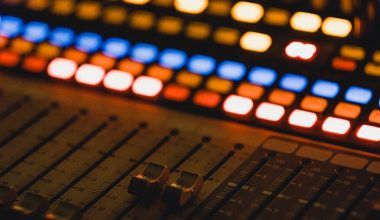Why Does Audio Quality Matter?
Have you ever listened to a song and felt something was missing? Maybe the sound wasn’t clear, or it didn’t feel rich. This happens because the audio quality wasn’t up to the mark. In today’s world, where music is streamed, downloaded, and shared across different platforms, knowing the best format for audio quality is super important.
If you’re an artist, a music lover, or just curious about how sound works, this blog is for you. Let’s talk about audio formats in a simple way and figure out what works best for your needs.
What Do We Mean by “Audio Quality”?
Before diving into formats, let’s understand what makes audio “good quality.” These three things decide how good sound can be:
- Bit Depth: Think of it like colors in a picture. More bit depth means more shades and richer details in sound. For example, 16-bit is standard, but 24-bit is even better.
- Sample Rate: This measures how many sound samples are taken per second. Common ones are 44.1kHz (CD quality) and 48kHz. Higher sample rates mean clearer sound.
- Compression: Some formats keep all the sound details, while others remove parts to save space. Keeping everything is “lossless,” and removing parts is “lossy.”
Audio Formats: What Are They?
An audio format is how sound is stored in a file. Each format has its strengths and weaknesses. Let’s explore the most popular ones.
1. WAV (Waveform Audio File)
WAV is like the king of audio formats. It doesn’t compress anything, so the sound is as good as it can get.
- Why It’s Great: It keeps all the sound details.
- When to Use: For recording music in a studio or editing sound.
- Downside: Files are very big, so it takes up a lot of space.
2. FLAC (Free Lossless Audio Codec)
FLAC is a favorite for music lovers who want the best quality but smaller file sizes than WAV.
- Why It’s Great: It keeps all the sound details but compresses the file to save space.
- When to Use: Storing your music library or distributing high-quality tracks.
- Downside: Not every device can play FLAC.
3. MP3 (MPEG Audio Layer III)
MP3 is the most common format for everyday use. It’s small and works on almost every device.
- Why It’s Great: Easy to share and doesn’t take much space.
- When to Use: Streaming music or casual listening.
- Downside: Some sound details are removed, so it’s not the best for critical listening.
4. AAC (Advanced Audio Codec)
AAC is like a newer, better version of MP3. Many platforms, like Apple Music, use it.
- Why It’s Great: Better sound than MP3 at the same file size.
- When to Use: Streaming music or downloading songs on your phone.
- Downside: Not as universal as MP3.
5. DSD (Direct Stream Digital)
DSD is super fancy and used for very high-quality recordings.
- Why It’s Great: Amazing sound for audiophiles.
- When to Use: Professional studio recordings.
- Downside: Huge files and not supported by most devices.
Lossless or Lossy: What’s the Difference?
When we talk about audio quality, “lossless” and “lossy” are key terms. Here’s what they mean:
- Lossless Formats: Keep everything in the sound. WAV and FLAC are great examples.
- Lossy Formats: Remove parts of the sound to make files smaller. MP3 and AAC are lossy.
Which Should You Pick?
- For creating or editing music: Choose lossless formats.
- For casual listening or sharing: Lossy formats work fine.
Why Does Format Matter for Artists?
If you’re an artist, the format you choose affects how people hear your music. Here’s why:
- Quality: Lossless formats like WAV make your music sound its best.
- Distribution: Streaming platforms like Spotify or Apple Music have specific format requirements.
- Storage: Large files need more space, which can be costly for indie artists.
Simple Tips to Choose the Best Format
- Personal Use: Use FLAC for your music library.
- Streaming: MP3 or AAC works best.
- Studio Work: Always go with WAV.
- For Audiophiles: DSD or FLAC will give you amazing quality.
How Streaming Platforms Use Formats
Every streaming service has its preferred format. Let’s look at some examples:
- Spotify: Uses Ogg Vorbis, which is like MP3 but slightly better.
- Apple Music: Uses AAC for better quality than MP3.
- Tidal: Offers FLAC for high-quality streaming.
If you’re an artist distributing music, platforms often prefer WAV files initially because they’re the highest quality. Later, they convert them for streaming.
How to Ensure the Best Audio Quality
Even the best format won’t help if the original recording isn’t good. Follow these tips:
- Record in Lossless: Always start with a lossless format like WAV.
- Use AI Mastering Tools: Platforms like Deliver My Tune offer mastering services to make your music sound polished.
- Test on Multiple Devices: Play your music on headphones, speakers, and phones to ensure it sounds great everywhere. (best format for audio quality)
Breaking Down Advanced Formats for Beginners
Some formats, like DSD and PCM, sound complicated but are easy to understand:
- PCM (Pulse-Code Modulation): Found in WAV files, this is the most common format in studios.
- DSD: Used for ultra-high-quality sound, like in movie production.
Future of Audio Formats (best format for audio quality)
The world of audio is always evolving. Here are some trends to watch:
- Spatial Audio: Formats like Dolby Atmos are becoming popular for immersive listening.
- High-Resolution Streaming: Platforms like Amazon Music HD and Tidal are pushing for better-than-CD-quality audio.
Common Questions About Audio Quality
1. Can I Hear the Difference Between Formats?
It depends on your ears and playback equipment. On good headphones, the difference between MP3 and FLAC is noticeable.
2. What’s the Best Format for Music Distribution?
WAV is usually best because it’s high quality and platforms can convert it for streaming.
3. Do I Need Special Equipment for FLAC or DSD?
Most modern devices support FLAC, but DSD often needs specific players.
Why WAV is Still the Best
WAV is the most reliable choice for quality. It’s the standard in studios and ensures your music is presented in the best possible way. If you’re serious about sound, start with WAV.
Conclusion: Pick What’s Right for You
Choosing the best format for audio quality depends on your needs. Here’s a quick summary:
- Recording: WAV.
- Storing Music: FLAC.
- Streaming: MP3 or AAC.
- Audiophiles: DSD.
If you’re an artist, platforms like Deliver My Tune can help you distribute your music in the right format. If you’re a listener, focus on what sounds best to you. After all, music is all about enjoyment!
Related Articles:
For further reading, explore these related articles:
- What Does Mono Speaker Mean? Easy Guide to Mono Speakers
- Everything You Need to Know About Viral Charts: A Simple Guide for Musicians
- The Ultimate Guide to Choosing the Best Microphone for Recording Vocals
For additional resources on music marketing and distribution, visit Deliver My Tune.






